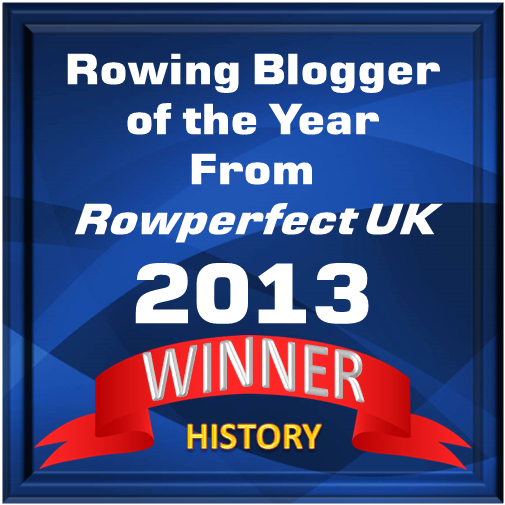 Following on from Tim Koch’s enquiry on 12 March and Göran Buckhorn’s follow-up on 13 March, I have found some information on Dermot St. John Gogarty’s involvement with Dublin University Boat Club (Trinity College, Dublin).
Following on from Tim Koch’s enquiry on 12 March and Göran Buckhorn’s follow-up on 13 March, I have found some information on Dermot St. John Gogarty’s involvement with Dublin University Boat Club (Trinity College, Dublin).In the late 1920s Trinity adopted Steve Fairbairn’s methods and found them to their liking. To implement the new style they needed a coach who was fully conversant with these methods and Dermot St. John Gogarty fitted this requirement perfectly. Gogarty first appeared at Islandbridge in 1933 and was an immediate success as Trinity’s senior coach. They retained the Irish Senior Eight Championship in 1933 having earlier won the University Grand Challenge Cup at Trinity Regatta. In the final of the ‘Grand’, they beat their alumni club, Lady Elizabeth Boat Club, a crew stroked by Gogarty.
 The 1933 Trinity College senior eight, Irish champions with Coach Dermot Gogarty wearing his London RC cap. (This photograph is from Michael Johnston’s book The Big Pot.)
The 1933 Trinity College senior eight, Irish champions with Coach Dermot Gogarty wearing his London RC cap. (This photograph is from Michael Johnston’s book The Big Pot.)Gogarty also kept his hand in by sculling for Lady Elizabeth and won The Emerald (senior) sculls at Trinity Regatta in 1933 and 1934. According to Raymond Blake in his wonderful book In Black & White, A History of Rowing at Trinity College, Dublin: “All this was only a sideshow compared to the serious preparation that was being undertaken for Henley”.
Gogarty was obsessed with winning the Ladies’ Plate and drawing on the experience of previous years Trinity only entered one event at Henley in 1934 and that, of course, was the Ladies’ Plate. They had earlier finished fourth in the Head of the River in London and won the senior eight at Boyne, Cork, and Limerick as well as at their home regatta.
Trinity progressed steadily to the final of the Ladies’ Plate and faced Jesus College, Cambridge, in the final. A contemporary account captured the excitement of the occasion:
“The greatest race of the day was the Ladies’ Plate. Jesus started at 11, 20½, 40. Trinity College, Dublin, at 10½, 20½, 39. Dublin got off very fast, and was half a length ahead at the top of the Island, and three quarters at the first signal. At the Barrier, reached in 1 minute 59 seconds, the same time as the Grand, they were rowing 35 to the 35 of Jesus. At Fawley (3 minutes 18 seconds) three seconds inside the record, Jesus went up a little, and at the next signal were only half a length behind. Here Jesus spurted at 38 against 36 and came up very fast to get level below the mile. Then Dublin gained a few feet at the mile and kept it till 100 yards from the finish. Jesus were a little better together, and in two splendid ‘tens’ at 40 up the enclosure which Dublin could not answer, they just got three feet ahead to reduce the record by seven seconds in 6 minutes 48 seconds. Nowhere over the course would Leander (the Grand winners) have been really clear of Jesus. They were the neatest, quickest, and longest Jesus crew since the Great War, and they improved with every day’s racing.”
 The 1934 senior eight, Ladies’ Plate finalists, photographed at Henley. Standing (left to right), R.M. Halahan (2), J.A.F. Montgomery (4), D. St. John Gogarty (coach), J.A. Shillington (captain, 1933), A.B.K. Tyndall (bow), T. Shillington (3). Sitting: J. Richards-Orpen (6), M. Horan (7), D. McGillycuddy (stroke), R.J. O’Neill (cox, in front), G.C. Drinkwater (coach), J.C.F. MacCarthy-Morrogh (5). (This photograph is from Raymond Blake’s book In Black & White.)
The 1934 senior eight, Ladies’ Plate finalists, photographed at Henley. Standing (left to right), R.M. Halahan (2), J.A.F. Montgomery (4), D. St. John Gogarty (coach), J.A. Shillington (captain, 1933), A.B.K. Tyndall (bow), T. Shillington (3). Sitting: J. Richards-Orpen (6), M. Horan (7), D. McGillycuddy (stroke), R.J. O’Neill (cox, in front), G.C. Drinkwater (coach), J.C.F. MacCarthy-Morrogh (5). (This photograph is from Raymond Blake’s book In Black & White.)The Henley adventure took a lot out of the Trinity crew and they were beaten in a heat of the 1934 Irish championship. However the foundation for an amazing sequence of results in the event was now in place and between 1935 and 1946 Trinity won ten out of twelve Irish senior eight championships.
It would seem that Gogarty was coaching at Trinity College, Dublin, University College, Dublin, and the London Rowing Club at the same time as well as sculling and stroking the ‘Lizzy’ eight. Architecture was certainly a lucrative and forgiving career in the 1930s! After his time with DUBC, he coached in Galway where he moved to in 1948.
(This post was corrected at 10 p.m. on 15 March, 2012)









.jpg)
)

Thank you for correcting the article to clearly identify Dermot Gogarty in the photographs. The original error was entirely mine and I apologize to HTBS readers that may have been misled.
ReplyDeleteAs a matter of interest it was not until 1977 that Trinity Coillege Dublin did manage to win the Ladies Plate at Henley Royal Regatta, a crew on which I was privileged to be a member. Then Vice president James Shillington sent a note of congratulations to the crew.. Maurice Horan, then Vice President famously returned a "missing" Leander flag from when he coached a losing TCD crew in 1950.(reported in Daily Telegraph Tuesday December 20, 1977)
ReplyDeleteDJSanfey